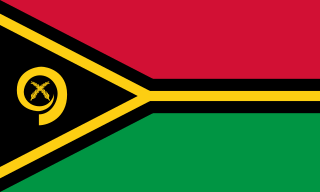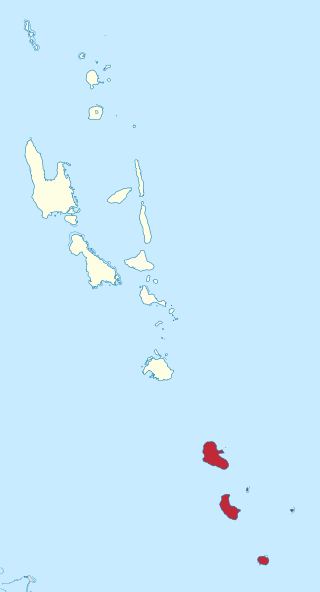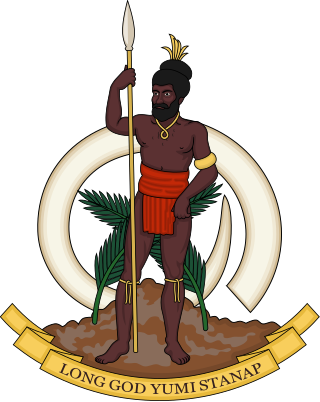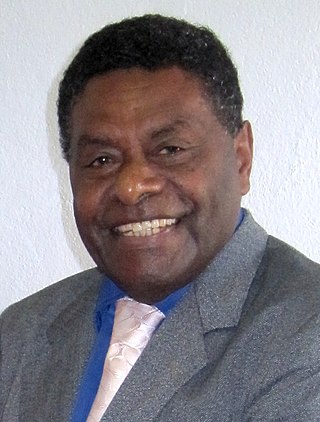
Vanuatu, officially the Republic of Vanuatu, is an island country in Melanesia located in the South Pacific Ocean. The archipelago, which is of volcanic origin, is 1,750 km (1,090 mi) east of northern Australia, 540 km (340 mi) northeast of New Caledonia, east of New Guinea, southeast of Solomon Islands, and west of Fiji.

John Frum is a figure associated with cargo cults on the island of Tanna in Vanuatu. He is often depicted as an American World War II serviceman who will bring wealth and prosperity to the people if they follow him. In a 1960 BBC documentary, British broadcaster David Attenborough asked the locals what Frum looked like and was told "'E look like you. 'E got white face. 'E tall man. 'E live 'long South America."

Tafea is the southernmost of the six provinces of Vanuatu. The name is an acronym for the five main islands that make up the province: Tanna, Aneityum, Futuna, Erromango and Aniwa.

Vanuatu has been divided into six provinces since 1994. The names in English of all provinces are derived from the initial letters of their constituent islands:

Tanna is an island in southern Vanuatu.

Hunter Island and Matthew Island are two small and uninhabited volcanic islands in the South Pacific, located 300 kilometres (190 mi) east of New Caledonia and south-east of Vanuatu archipelago. Hunter Island and Matthew Island, 70 km (43 mi) apart, are claimed by Vanuatu as part of Tafea Province, and considered by the people of Aneityum part of their custom ownership, and as of 2007 were claimed by France as part of New Caledonia.
The nine South Vanuatu languages form a family of the Southern Oceanic languages, spoken in Tafea Province of Vanuatu.

Aneityum is the southernmost island of Vanuatu, in the province of Tafea.

Ambae, also known as Aoba, Omba, Oba, or Opa and formerly Lepers’ Island, is an island in the South Pacific island nation of Vanuatu, located near 15°30′S167°30′E, approximately 310 kilometres north-northwest of Vanuatu's capital city, Port Vila. It is also Vanuatu's largest active volcano.

Erromango is the fourth largest island in the Vanuatu archipelago. With a land area of 891.9 square kilometres (344.4 sq mi), it is the largest island in Tafea Province, the southernmost of Vanuatu's six administrative regions.

Aniwa is a small island in the southernmost province of Tafea, Vanuatu.

Mota is an island in the Banks group of northern Vanuatu. Its population – today about 700 people – speak the Mota language, which Christian missionaries of the Anglican Church used as a lingua franca in parts of Melanesia.
Anejom̃ or Aneityum is an Oceanic language spoken by 900 people on Aneityum Island, Vanuatu. It is the only indigenous language of Aneityum.

Christianity is the largest religion in Vanuatu. Vanuatu is an archipelago made up of 13 larger islands, and approximately 70 smaller surrounding islands, each home to multitudes of diverse cultural and religious communities.

This article presents an overview of the culture of Vanuatu.

Iolu Johnson Abil is a Vanuatuan politician. He was elected and sworn in as the president of Vanuatu on 2 September 2009.

Tanna is a 2015 Australian-Ni-Vanuatu film set on the island of Tanna in the South Pacific, depicting the true story of a couple who decided to marry for love, rather than obey their parents' wishes. Starring Marie Wawa and Mungau Dain, the film is based on an actual marriage dispute.

Inyeug Island is a small uninhabited island in Tafea Province of Vanuatu in the Pacific Ocean. "Inyeug" means "Small Island" in a local language. Inyueg is also called Mystery Island by the cruise ships that regularly visit the island.


















